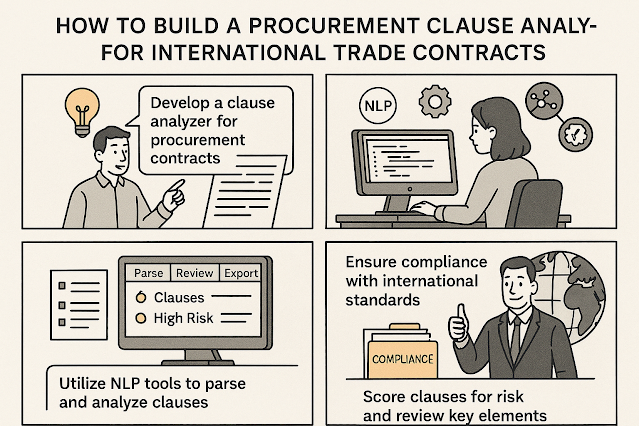How to Build a Procurement Clause Analyzer for International Trade Contracts
In a world of complex global supply chains, navigating international trade contracts can be daunting—especially when it comes to procurement clauses.
Missed risks or poorly worded terms can cost millions.
This is where a procurement clause analyzer becomes a game-changer for legal, compliance, and procurement teams operating internationally.
Let’s walk through how to build one—step-by-step.
📌 Table of Contents
- Why a Procurement Clause Analyzer Matters
- Core Features Your Analyzer Should Include
- Tech Stack and Tools to Use
- Clause Parsing & Logic Engine Setup
- Training the NLP Model
- Designing the Interface
- International Compliance Considerations
- Deployment and Real-World Testing
- Useful Resources
🌍 Why a Procurement Clause Analyzer Matters
International contracts vary in structure, wording, and legal implications depending on the jurisdiction.
Procurement clauses define how goods or services are sourced, timelines, penalties, and dispute resolution mechanisms.
A clause analyzer allows for early identification of red flags, vague terms, or non-compliance with local regulations.
It also helps organizations compare supplier agreements efficiently across regions.
🛠️ Core Features Your Analyzer Should Include
- **Clause Segmentation**: Automatically identify procurement-related segments.
- **Term Highlighting**: Flag terms like “reasonable efforts,” “delivery obligations,” or “force majeure.”
- **Risk Scoring**: Assess the risk level of a clause based on predefined legal rules or AI models.
- **Comparative Review**: Allow side-by-side clause comparison across multiple contracts.
🧰 Tech Stack and Tools to Use
- **Natural Language Processing**: spaCy, GPT APIs, or NLTK for clause recognition and categorization.
- **Backend**: Python with Flask or Node.js with Express for API handling.
- **Database**: PostgreSQL or MongoDB to store contract metadata and clause history.
- **Frontend**: React or Vue.js for interactive, responsive UIs.
🧠 Clause Parsing & Logic Engine Setup
Create a rule-based engine combined with ML classification.
Use clause-type tags such as delivery timeline, performance standards, and termination rights.
Build logic that checks each clause against a benchmark model (e.g., INCOTERMS).
Highlight ambiguities or missing details in real time.
📊 Training the NLP Model
Use open datasets such as the UN Convention on Contracts for the International Sale of Goods (CISG) and annotated procurement contracts.
Fine-tune a transformer model (e.g., BERT or GPT-4) to classify and extract procurement clauses with context.
Continuously train on real-world contracts to improve precision and recall.
🖥️ Designing the Interface
Legal users need clarity.
Design UI/UX with collapsible clause views, tooltips for legal terms, and exportable summaries.
Include a search function that allows users to filter clauses by risk level, jurisdiction, or keywords.
📑 International Compliance Considerations
Your analyzer must account for legal variations across countries.
Procurement terms in the U.S., EU, China, and Middle East differ in scope and enforceability.
Incorporate legal rule sets per region and display them as footnotes in the analysis result.
🚀 Deployment and Real-World Testing
Deploy on secure cloud infrastructure (AWS/GCP).
Ensure contracts are encrypted at rest and in transit (TLS, AES-256).
Run beta tests with legal teams and procurement officers using real anonymized contracts.
Collect feedback, iterate models, and deploy updates monthly.
🔗 Useful Resources
To see real-world applications and complementary tools, explore this blog below:
🔎 Visit Detecinfor - Legal Tech Use CasesThis is a valuable reference filled with guides on AI-driven contract analysis and clause interpretation.
Final Thoughts
In a globalized economy, contract clarity isn't a luxury—it’s a necessity.
Building a procurement clause analyzer will not only empower legal teams but also accelerate decision-making and reduce contract-related risks.
It’s a forward-thinking solution every international business should consider.
Keywords: procurement clause analyzer, international trade contracts, contract risk scoring, legal NLP tools, clause parsing

